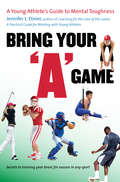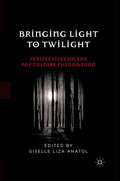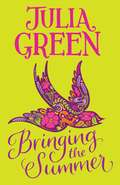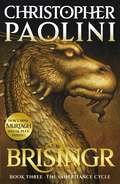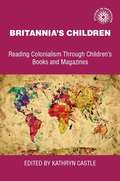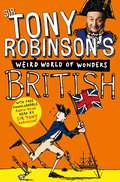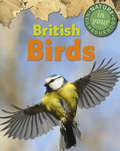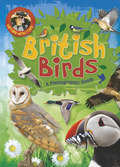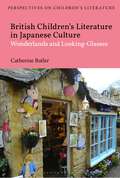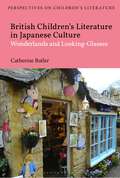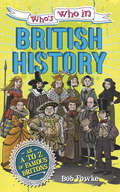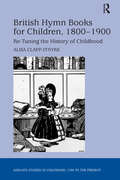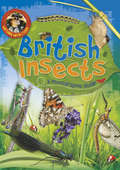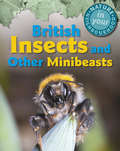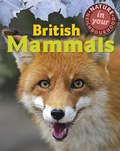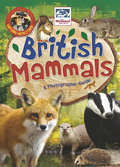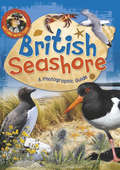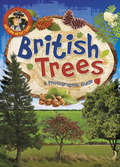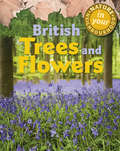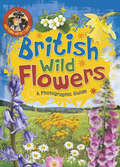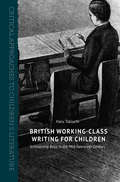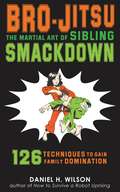- Table View
- List View
Bring Your "A" Game: A Young Athlete's Guide to Mental Toughness
by Jennifer L. EtnierMental training is just as important as physical training when it comes to success in sport. And like physical fitness, mental toughness is something that can be taught and learned. Yet many young athletes have not learned the psychological skills needed to develop their best game. This book was written specifically for young athletes interested in improving their performance and reaching their potential in sport. Bring Your "A" Game introduces key strategies for mental training, such as goal setting, pre-performance routines, confidence building, and imagery. Each of the seventeen chapters focuses on a single mental skill and offers key points and exercises designed to reinforce the concepts. The book encourages athletes to incorporate these mental skills into their daily lives and practice sessions so that they become second nature during competition.Whether used at home by student athletes or assigned by coaches as part of team development, Bring Your "A" Game will help young performers develop a plan for success and learn to deal with the challenges of pursuing excellence in sport.
Bringing Light to Twilight: Perspectives on a Pop Culture Phenomenon
by Giselle Liza AnatolThe essays in this collection use the interpretative lens to interrogate the meanings of Meyer's books, making a compelling case for the cultural relevance of Twilight and providing insights on how we can "read" popular culture to our best advantage.
Bringing the Summer
by Julia GreenIt's the lazy end of summer and Freya is about to start her A levels. Her brother Joe died a year ago, but she is slowly coming to terms with his death. She is beginning to feel ready for something new - a change. And then a railway accident brings her by chance into contact with the gorgeous Gabes. Freya is drawn not just to Gabes himself and his blond good looks, but everything about him, including his large, shambolic, warm and loving family, which seems to Freya so different to her own family of three.And then Gabes' clearly troubled older brother makes it clear he is interested in Freya - and Freya has some decisions to make about what she really wants.
Brisingr: Book Three (The Inheritance Cycle #3)
by Christopher PaoliniOaths sworn . . . Loyalties tested . . . Forces collide.Eragon and his dragon, Saphira, have narrowly escaped with their lives after the colossal battle against the Empire's warriors on the Burning Plains. Now Eragon finds himself bound by promises he may not be able to keep. He must help rescue his cousin Roran's beloved from King Galbatorix's clutches. But he also owes his loyalty to the Varden, the elves and the dwarves, who are in desperate need of his talents and strength. Eragon in the greatest hope to rid the land of tyranny. Can this once simple farm boy unite the rebel forces and defeat the king?
Britannia's children: Reading colonialism through children's books and magazines (Studies in Imperialism #26)
by Kathryn CastleMany European countries, their imperial territories, and rapidly Europeanising imitators like Japan, established a powerful zone of intellectual, ideological and moral convergence in the projection of state power and collective objectives to children. This book is an introduction to the 'imperial' images of the Indian, African and Chinese, created for the youth of Britain through their history textbooks and popular periodicals. Focusing on materials produced for children, by textbook historians and the popular press, it provides a study of both the socialization of the young and the source of race perceptions in 20th-century British society. Against a backdrop of promoting the 'wonderful development of the Anglo-Saxon race', textbook historians approached British India as the primary example of imperial achievement. Chinese characters continued to feature in the periodicals in a variety of situations, set both in China and the wider world. Africa was a favoured setting for adventure in the years between the world wars, and African characters of long standing retained their popularity. While much of the 'improving' material began to disappear, reflecting the move toward a youth-centred culture, Indian, African and Chinese characters still played an important role in stories and features. The images of race continued into the inter-war years. The book shows how society secures the rising generation in the beliefs of the parent society, and how the myths of race and nationality became an integral part of Britain's own process of self identification.
Britannia's children: Reading colonialism through children's books and magazines (Studies in Imperialism #26)
by Kathryn CastleMany European countries, their imperial territories, and rapidly Europeanising imitators like Japan, established a powerful zone of intellectual, ideological and moral convergence in the projection of state power and collective objectives to children. This book is an introduction to the 'imperial' images of the Indian, African and Chinese, created for the youth of Britain through their history textbooks and popular periodicals. Focusing on materials produced for children, by textbook historians and the popular press, it provides a study of both the socialization of the young and the source of race perceptions in 20th-century British society. Against a backdrop of promoting the 'wonderful development of the Anglo-Saxon race', textbook historians approached British India as the primary example of imperial achievement. Chinese characters continued to feature in the periodicals in a variety of situations, set both in China and the wider world. Africa was a favoured setting for adventure in the years between the world wars, and African characters of long standing retained their popularity. While much of the 'improving' material began to disappear, reflecting the move toward a youth-centred culture, Indian, African and Chinese characters still played an important role in stories and features. The images of race continued into the inter-war years. The book shows how society secures the rising generation in the beliefs of the parent society, and how the myths of race and nationality became an integral part of Britain's own process of self identification.
British (Sir Tony Robinson's Weird World of Wonders #3)
by Sir Tony RobinsonIn Sir Tony Robinson's Weird World of Wonders British, Sir Tony Robinson takes you on a headlong gallop through time, pointing out all the most important, funny, strange, amazing, entertaining, smelly and disgusting bits about the British! It's history, but not as we know it!Find out everything you ever needed to know in this brilliant, action-packed, fact-filled book, including:- How to avoid scurvy- Why bright red isn't the best colour for a soldier's uniform- Why not being able to swim was considered an advantage, and- How to cure the most gruesome tropical diseasesFor more funny history facts discover Greeks and Romans.
British Birds (Nature in Your Neighbourhood #3)
by Clare CollinsonFrom familiar garden songbirds to powerful birds of prey, there are a whole host of fascinating birds to discover in Britain. Learn all about the remarkable range of British birds inside this book. Find out where to look for different species, how to identify them, when to spot them and much more.The book is part of the 'Nature in your neighbourhood' series - discover the plants and animals that live all around you!
British Birds: British Birds (library Ebook) (Nature Detective #1)
by Victoria MunsonThis book introduces more than 50 of the most common birds found in Britain today. There are full descriptions of the birds, along with their scientific name, size, family and habitat. Full colour photographs will help with easy identification. Includes advice on how to be a good birdwatcher, such as best places to see birds and how to take notes to aid recognition, and tips on how to attract birds to your garden or local area. Find out how to make bird food to help birds survive the winter.Birds featured: Barn Owl, Black-headed Gull, Blackbird, Blackcap, Blue Tit, Bullfinch, Buzzard, Canada Goose, Carrion Crow, Chaffinch, Coal Tit, Collared Dove, Common Gull, Coot, Cormorant, Cuckoo, Dunnock, Feral Pigeon, Fieldfare, Goldfinch, Great Crested Grebe, Great Spotted Woodpecker, Great Tit, Green Woodpecker, Greenfinch, Grey Heron, Grey Partridge, Grey Wagtail, Greylag Goose, Herring Gull, House Martin, House Sparrow, Jackdaw, Jay, Kestrel, Kingfisher, Little Grebe, Long-tailed Tit, Magpie, Mallard, Mistle Thrush, Moorhen, Mute Swan, Nuthatch, Pheasant, Pied Wagtail, Pigeon, Pochard, Puffin, Raven, Red Kite, Redwing, Ring-necked Parakeet, Robin, Rook, Shag, Siskin, Song Thrush, Sparrowhawk, Starling, Swallow, Swift, Tawny Owl, Tree Sparrow, Tufted duck, White Wagtail, Woodpigeon, Wren.
British Children's Literature in Japanese Culture: Wonderlands and Looking-Glasses (Bloomsbury Perspectives on Children's Literature)
by Dr Catherine ButlerWhether watching Studio Ghibli adaptations of British children's books, visiting Harry Potter sites in Britain or eating at Alice in Wonderland-themed restaurants in Tokyo, the Japanese have a close and multifaceted relationship with British children's literature. In this, the first comprehensive study to explore this engagement, Catherine Butler considers its many manifestations in print, on the screen, in tourist locations and throughout Japanese popular culture. Taking stock of the influence of literary works such as Gulliver's Travels, Alice's Adventures in Wonderland, The Tale of Peter Rabbit, Tom's Midnight Garden, and the Harry Potter series, this lively account draws on literary criticism, translation, film and tourist studies to explore how British children's books have been selected, translated, understood, adapted and reworked into Japanese commercial, touristic and imaginative culture. Using theoretically informed case studies this book will consider both individual texts and their wider cultural contexts, translations and adaptations (such as the numerous adaptations of British children's books by Studio Ghibli and others), the dissemination of distinctive tropes such as magical schools into Japanese children's literature and popular culture, and the ways in which British children's books and their settings have become part of way that Japanese people understand Britain itself.
British Children's Literature in Japanese Culture: Wonderlands and Looking-Glasses (Bloomsbury Perspectives on Children's Literature)
by Dr Catherine ButlerWhether watching Studio Ghibli adaptations of British children's books, visiting Harry Potter sites in Britain or eating at Alice in Wonderland-themed restaurants in Tokyo, the Japanese have a close and multifaceted relationship with British children's literature. In this, the first comprehensive study to explore this engagement, Catherine Butler considers its many manifestations in print, on the screen, in tourist locations and throughout Japanese popular culture. Taking stock of the influence of literary works such as Gulliver's Travels, Alice's Adventures in Wonderland, The Tale of Peter Rabbit, Tom's Midnight Garden, and the Harry Potter series, this lively account draws on literary criticism, translation, film and tourist studies to explore how British children's books have been selected, translated, understood, adapted and reworked into Japanese commercial, touristic and imaginative culture. Using theoretically informed case studies this book will consider both individual texts and their wider cultural contexts, translations and adaptations (such as the numerous adaptations of British children's books by Studio Ghibli and others), the dissemination of distinctive tropes such as magical schools into Japanese children's literature and popular culture, and the ways in which British children's books and their settings have become part of way that Japanese people understand Britain itself.
British History: British History (library Ebook) (Who's Who in)
by Robert Fowke'Who's Who in British History' contains biographies of 250 of the most important people in British history. Written in an informal, friendly style, the book provides essential information about their lives. Aimed at children of 8-12 years, the book is easy to use, with cross references, a glossary and an index. The text is interspersed with appealing cartoon-style illustrations.Includes a huge range of biographies from kings and queens, artists, saints, writers, inventors, sporting heroes, explorers, politicians and statesment, philanthropists, pilots, rebels and villains, pretenders to the throne to teachers, warriors and fashion victims.Expert consultant: Dr Miles Taylor of King's College, University of London.
British Hymn Books for Children, 1800-1900: Re-Tuning the History of Childhood (Studies in Childhood, 1700 to the Present)
by Alisa Clapp-ItnyreExamining nineteenth-century British hymns for children, Alisa Clapp-Itnyre argues that the unique qualities of children's hymnody created a space for children's empowerment. Unlike other literature of the era, hymn books were often compilations of many writers' hymns, presenting the discerning child with a multitude of perspectives on religion and childhood. In addition, the agency afforded children as singers meant that they were actively engaged with the text, music, and pictures of their hymnals. Clapp-Itnyre charts the history of children’s hymn-book publications from early to late nineteenth century, considering major denominational movements, the importance of musical tonality as it affected the popularity of hymns to both adults and children, and children’s reformation of adult society provided by such genres as missionary and temperance hymns. While hymn books appear to distinguish 'the child' from 'the adult', intricate issues of theology and poetry - typically kept within the domain of adulthood - were purposely conveyed to those of younger years and comprehension. Ultimately, Clapp-Itnyre shows how children's hymns complicate our understanding of the child-adult binary traditionally seen to be a hallmark of Victorian society. Intersecting with major aesthetic movements of the period, from the peaking of Victorian hymnody to the Golden Age of Illustration, children’s hymn books require scholarly attention to deepen our understanding of the complex aesthetic network for children and adults. Informed by extensive archival research, British Hymn Books for Children, 1800-1900 brings this understudied genre of Victorian culture to critical light.
British Hymn Books for Children, 1800-1900: Re-Tuning the History of Childhood (Studies in Childhood, 1700 to the Present)
by Alisa Clapp-ItnyreExamining nineteenth-century British hymns for children, Alisa Clapp-Itnyre argues that the unique qualities of children's hymnody created a space for children's empowerment. Unlike other literature of the era, hymn books were often compilations of many writers' hymns, presenting the discerning child with a multitude of perspectives on religion and childhood. In addition, the agency afforded children as singers meant that they were actively engaged with the text, music, and pictures of their hymnals. Clapp-Itnyre charts the history of children’s hymn-book publications from early to late nineteenth century, considering major denominational movements, the importance of musical tonality as it affected the popularity of hymns to both adults and children, and children’s reformation of adult society provided by such genres as missionary and temperance hymns. While hymn books appear to distinguish 'the child' from 'the adult', intricate issues of theology and poetry - typically kept within the domain of adulthood - were purposely conveyed to those of younger years and comprehension. Ultimately, Clapp-Itnyre shows how children's hymns complicate our understanding of the child-adult binary traditionally seen to be a hallmark of Victorian society. Intersecting with major aesthetic movements of the period, from the peaking of Victorian hymnody to the Golden Age of Illustration, children’s hymn books require scholarly attention to deepen our understanding of the complex aesthetic network for children and adults. Informed by extensive archival research, British Hymn Books for Children, 1800-1900 brings this understudied genre of Victorian culture to critical light.
British Insects: Insects (Nature Detective #6)
by Victoria MunsonFind out about 50 of the most common insects found in Britain today. Full descriptions of the insects, along with their scientific name, size, family and habitat, will help you to recognise which insect is which. Beautiful, large colour photographs will help make identification easy.Includes fascinating information about different insects life cycle, their unique body parts and where they like to live.A simple activity shows you how to protect insects through the winter. Become a nature detective and explore the natural world around you. If you enjoy this book, then why not search out the other titles in this series: British Birds; British Mammals; British Trees; British Wild Flowers and British Seashore.
British Insects and other Minibeasts (Nature in Your Neighbourhood #1)
by Clare CollinsonThere are more insects and other minibeasts in British neighbourhoods than any other kind of animal. Whether you are at home, walking down the street, in a meadow or by a river, there's plenty of minibeasts to discover! In this book discover a range of minibeasts from bees, butterflies and bugs to worm and woodlice. It is full of great nature-spotting tips and includes information about the classification of insects.The book is part of the 'Nature in your neighbourhood' series - find out all about the plants and animals that live all around you!
British Mammals (Nature in Your Neighbourhood #2)
by Clare CollinsonWherever you live in Britain, you will be amazed at how much mammal life there is right on your doorstep. Even in the busiest cities, there are small rodents, such as this squirrel, and larger predators, such as foxes. In this book find out all about the mammals that live in British cities, the coutryside and in our waterways. Discover the best ways to spot them and learn about the classification of mammals.The book is part of the 'Nature in your neighbourhood' series - find out all about the plants and animals that live all around you!
British Mammals: British Mammals (library Ebook) (Nature Detective #2)
by Victoria MunsonThis book introduces 50 of the most common mammals found in Britain today. There are full descriptions of the scientific name, size, food and habitat of each animal. Full colour photographs will help with easy identification. Includes advice on how to be a good nature detective, such as best places to see these mammals and how to take notes to aid recognition. Activities at the end of the book show how to make animal homes and identify footprints.
British Seashore: Seashore (Nature Detective #5)
by Victoria MunsonFind out about the most common plants, insects, crustaceans, seasweeds, molluscs and birds found on British seashores today. Full descriptions of each, along with their scientific name, size, family and food. Beautiful, large colour photographs will make identification easy. Includes fascinating information about rock pools, the tides, food chains and safety at the beach.From shells and anemones, to jellyfish and crabs, lugworms, urchins, sandhoppers, butterflies and gulls, a world of wildlife waits for you to discover it. Become a nature detective and explore the natural world around you. If you enjoy this book, then why not search out the other titles in this series: British Birds; British Mammals; British Trees; British Wild Flowers and British Insects.
British Trees: Trees (library Ebook) (Nature Detective #3)
by Victoria MunsonFind out about more than 50 of the most common trees found in Britain today. Full descriptions of the trees, along with their scientific name, size, family and habitat, will ensure you can recognise which tree is which. Beautiful large colour photographs of the trees, their leaves, seeds and fruits, will help with easy identification. Includes information about broadleaved trees and conifers, explaining the difference between deciduous trees and evergreens, and looks at how the parts of trees, from the leaves and bark to seeds and berries, can help you to recognise each tree.You can also follow a step-by-step activity to help you create your own tree guide. Become a nature detective and explore the natural world around you. If you enjoy this book, then why not search out the other titles in this series: British Birds; British Mammals; British Insects; British Wild Flowers and British Seashore.Features the following trees: English Oak, Turkey Oak, Sessile Oak, Aspen, White Willow, Weeping Willow, Pussy Willow, Crack Willow, Common Osier, Black Poplar, White Poplar, Silver Birch, Alder, Hazel, Hornbeam, Common Beech, Common Ash, Elder, Holly, Common Lime, Large-leave Lime, Small-leaved Lime, London Plane, Rowan, Horse Chestnut, Sweet Chestnut, Field Maple, Sycamore, Yew, Wych Elm, English Elm, Whitebeam, Hawthorn, Blackthorn, Crab Apple, Wild Cherry, Common Pear, Common Juniper, Walnut, Magnolia, Norway Spruce, Larch, Douglas Fir, Scots Pine, Sitka Spruce, Cedar, Monkey Puzzle Tree.
British Trees and Flowers (Nature in Your Neighbourhood #4)
by Clare CollinsonFrom magnificent oaks to delicate bluebells, there are a whole host of trees and flowers to discover in Britain. Learn all about the extraordinary range of trees and wild flowers that grow in British neighbourhoods. Find out where to look for different species, how to identify them and much more.The book is part of the 'Nature in your neighbourhood' series - find out all about the plants and animals that live all around you!
British Wild Flowers: Wild Flowers (Nature Detective #4)
by Victoria MunsonFind out about more than 50 of the most common wild flowers found in Britain today. Full descriptions of the flowers, along with their scientific name, size, family and habitat, will help you to recognise which flower is which. Beautiful, large colour photographs will help make identification easy. Includes information about the parts of a flower, plant life cycles, photosynthesis and looks at why wild flowers need to be protected.Follow a simple step-by-step activity to make your own wild flower window-box, hanging basket or garden. Become a nature detective and explore the natural world around you. If you enjoy this book, then why not search out the other titles in this series: British Birds; British Mammals; British Trees; British Insects and British Seashore.Features the following flowers: Common Mallow; Red Campion; Ragged-Robin; Field Bindweed; Heather; Rosebay Willowherb, Foxglove; Harebell; Common Comfrey; Tufted Vetch; Teasel; Spear Thistle; Common Poppy; Scarlet Pimpernel; Meadow Buttercup; Creeping Buttercup; Common Bird's-foot-trefoil; Dandelion; Perforate St John's Wort; Tansy; Wild Daffodil; Yellow Iris; Lesser Celandine; Marsh-marigold; Shepherd's Purse; Cuckoo Flower; Dog-Rose; Bramble; Wild Strawberry; Meadowsweet; Cow Parsley; Hemlock; Yarrow; White Clover; Common Daisy; Oxeye Daisy; Garlic Mustard; Ramsons; Wood Anemone; Lily-of-the-Valley; Common Snowdrop; Cleavers; Stinging Nettle; White Deadnettle; Field Forget-Me-Not; Viper's Bugloss; Bluebell; Cornflower.
British Working-Class Writing for Children: Scholarship Boys in the Mid-Twentieth Century
by Haru TakiuchiThis book explores how working-class writers in the 1960s and 1970s significantly reshaped British children’s literature through their representations of working-class life and culture. Aidan Chambers, Alan Garner and Robert Westall were examples of what Richard Hoggart termed ‘scholarship boys’: working-class individuals who were educated out of their class through grammar school education. This book highlights the role these writers played in changing the publishing and reviewing practices of the British children's literature industry while offering new readings of their novels featuring scholarship boys. As well as drawing on the work of Raymond Williams and Pierre Bourdieu, and referring to studies of scholarship boys in the fields of social science and education, this book also explores personal interviews and previously-unseen archival materials. Yielding significant insights on British children’s literature of the period, this book will be of particular interest to scholars and students in the fields of children’s and working-class literature and of British popular culture.
British Working-Class Writing for Children: Scholarship Boys in the Mid-Twentieth Century (PDF)
by Haru TakiuchiThis book explores how working-class writers in the 1960s and 1970s significantly reshaped British children’s literature through their representations of working-class life and culture. Aidan Chambers, Alan Garner and Robert Westall were examples of what Richard Hoggart termed ‘scholarship boys’: working-class individuals who were educated out of their class through grammar school education. This book highlights the role these writers played in changing the publishing and reviewing practices of the British children's literature industry while offering new readings of their novels featuring scholarship boys. As well as drawing on the work of Raymond Williams and Pierre Bourdieu, and referring to studies of scholarship boys in the fields of social science and education, this book also explores personal interviews and previously-unseen archival materials. Yielding significant insights on British children’s literature of the period, this book will be of particular interest to scholars and students in the fields of children’s and working-class literature and of British popular culture.
Bro-Jitsu: The Martial Art of Sibling Smackdown
by Daniel H. WilsonBro-jitsu is a highly stylized form of physical and mental combat that has been practiced and honed to perfection over countless millennia by billions of human beings who all have one crucial thing in common: annoying siblings. The book breaks down Bro-jitsu into three strategies: offensive moves, defensive moves, and psychological manipulation. Each section delivers step-by-step instructions on performing crucial techniques, from the classic Wet Willy to the inventive Full-Body Defensive Fish Wiggle. No sibling should be without it!
